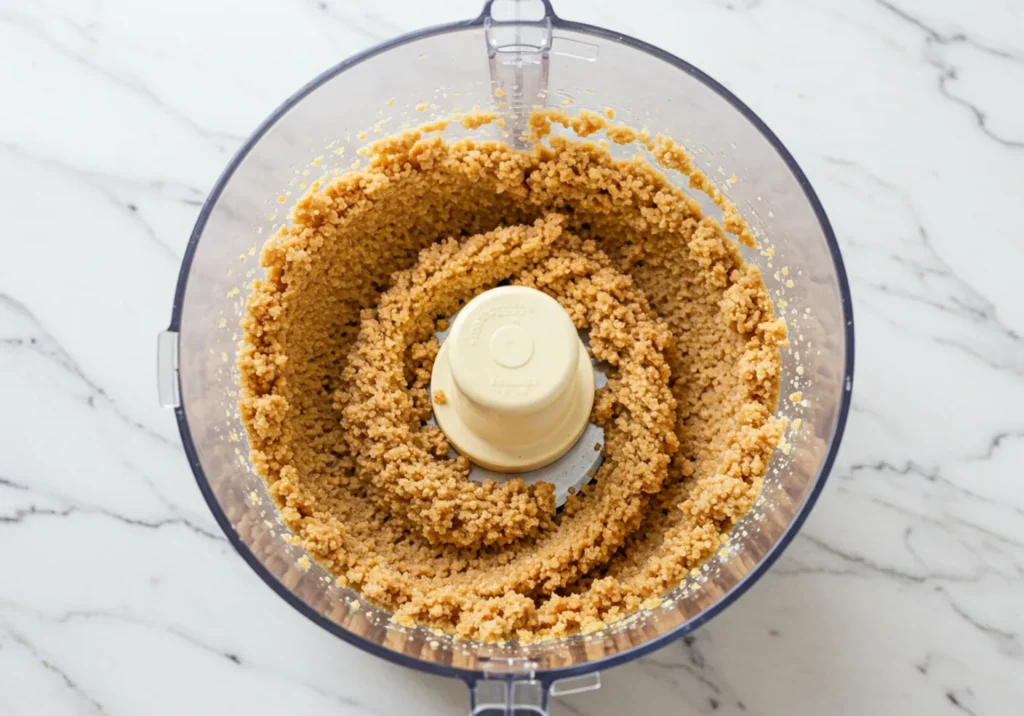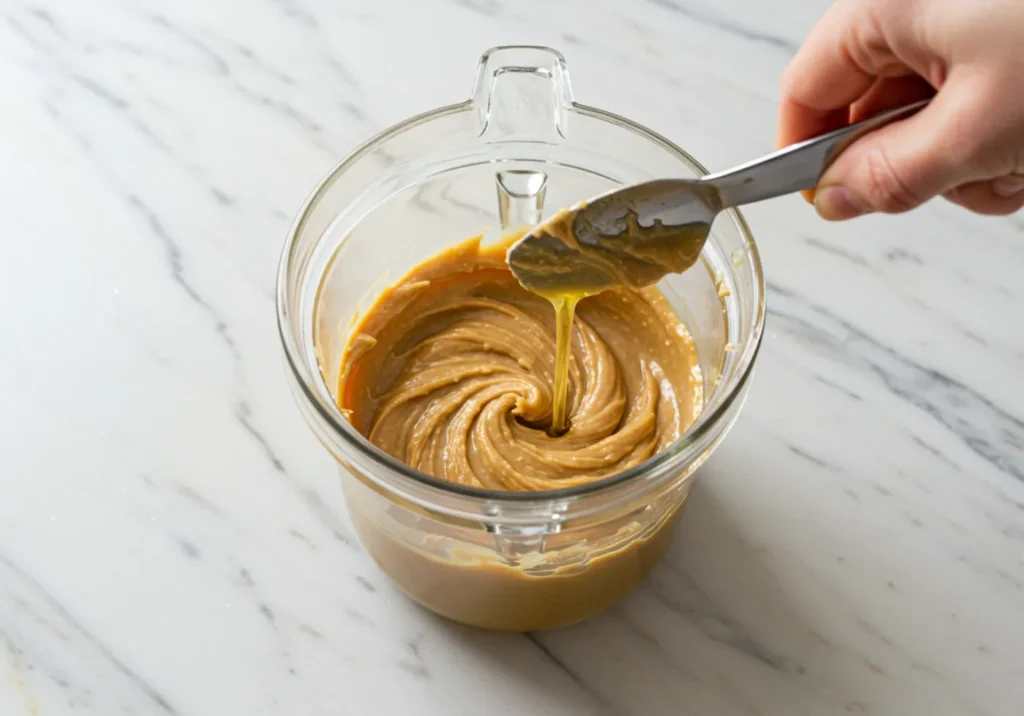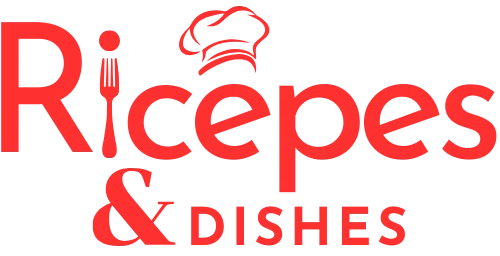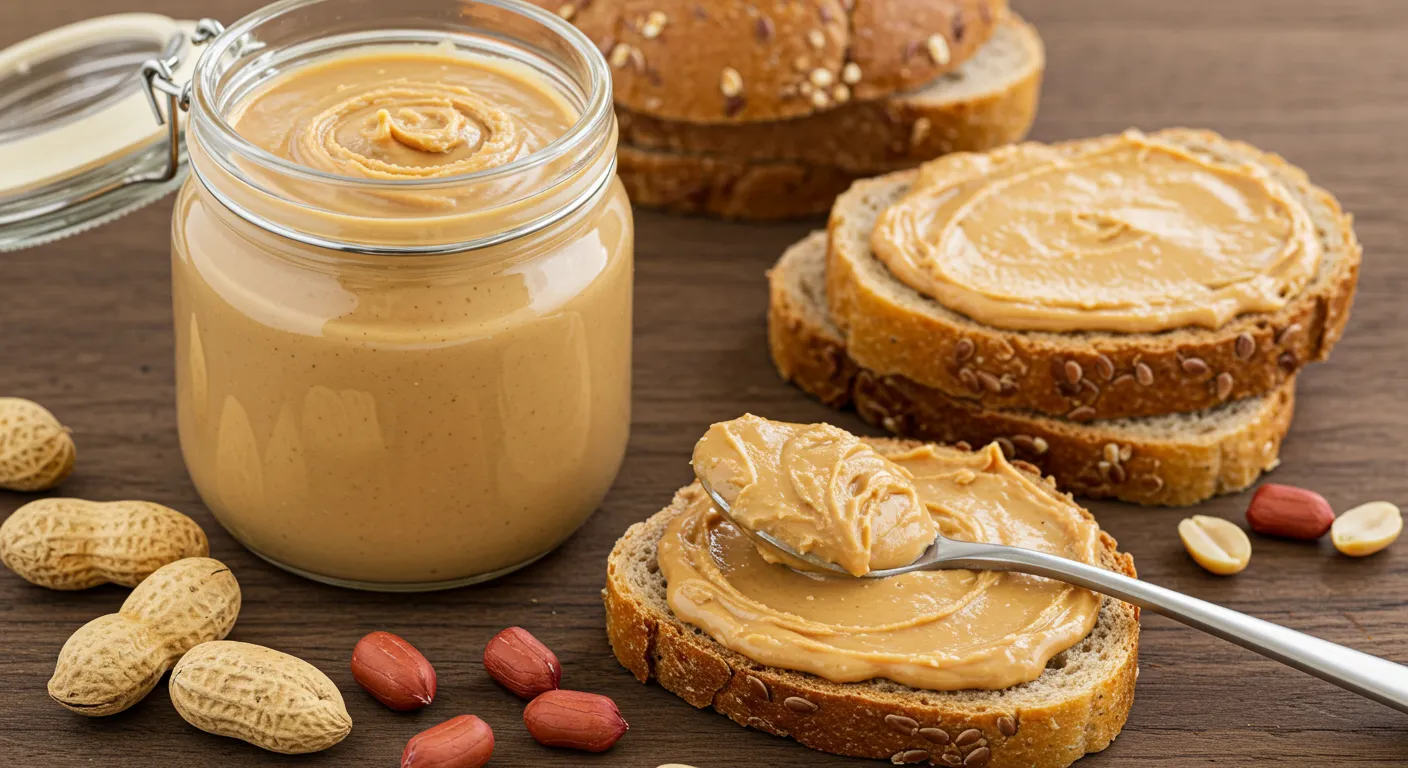Natural peanut butter—sounds fancy, doesn’t it? But honestly, it’s just peanuts doing their thing without any weird add-ins. And trust me, once you’ve tried it, there’s no going back to the sugary, mystery-ingredient jars you’ve been spooning out of. In this guide, we’re going to dig into everything you need to know about this creamy (or chunky, if that’s your vibe) spread. We’ll chat about what makes natural peanut butter special, the super simple ingredients it’s made of, and why it’s actually pretty good for you. I mean, who doesn’t love a food that’s healthy and delicious?
But wait, there’s more! We’ll also spill the tea on the best brands out there, how to pair it with your favorite snacks, and even where it fits into a classic Banana Bread Recipe (oh yes, it’s a game-changer). Whether you’re slathering it on toast, blending it into a smoothie, or just eating it straight out of the jar—no judgment here—you’re about to get the full scoop on this peanut-packed goodness. Grab a spoon (or your snack of choice) and read on because it’s time to go nuts!
Table of Contents
Ingredients of Natural Peanut Butter
Ingredients
- 2 cups unsalted roasted peanuts (preferably dry roasted)
- 1-2 tbsp peanut oil (optional, depending on your desired consistency)
- 1 tsp honey (optional for a touch of sweetness)
- Pinch of salt (optional, depending on your taste)
Instructions
Blend the peanuts:
Add the roasted peanuts to a food processor. Blend on high for about 2-3 minutes, scraping down the sides as necessary. The peanuts will start out chunky and gradually turn into a crumbly paste. Keep blending!

Add oil and sweetness:
Once the peanut butter begins to form, add peanut oil, a bit at a time, to reach your preferred consistency. If you like a smoother peanut butter, use more oil. Add honey for sweetness and salt if desired, blending until smooth.

Adjust texture:
If you prefer chunky peanut butter, stop blending when the desired consistency is reached. For creamy peanut butter, continue processing until smooth and velvety.
Store and enjoy:
Transfer your homemade peanut butter to a jar or airtight container. Store in the fridge for up to 2-3 weeks. Enjoy it on toast, in smoothies, or straight off the spoon!
If you’ve been using jarred spreads with a million ingredients, switching to natural peanut butter might blow your mind. You actually get to taste real peanuts, and, trust me, it’s a game-changer—not much different from when someone tweaks a Banana Bread Recipe to make it healthier and way tastier.
Importance of No Additives or Preservatives
Why all the fuss about keeping it natural? Well, adding oils or sugar can mess with both the taste and the health benefits. Preservatives just extend shelf life but take away that homemade, wholesome vibe. Imagine eating fresh peanut butter that handles like the smoothest thing on Earth—it feels like a gift from the peanut gods!
Natural peanut butter keeps things pure and simple, so you can feel good about spreading it on your toast or dunking your apple slices into it. Oh, and if you’re wondering about the separation (you know, that oil floating on top)—don’t sweat it. It’s completely normal since there are no stabilizers. Just stir it up, and you’re good to go!
Health Benefits of Natural Peanut Butter
Nutritional Profile
Alright, here’s the deal—natural peanut butter is one of those magic foods that’s both yummy and good for you. Shocker, right? It’s loaded with protein—about 8 grams per 2-tablespoon serving—which means you can stay fuller for longer. It’s also packed with healthy fats (those mono- and poly-whatchamacallits), which BTW are the good fats your body actually loves.
Oh, and guess what? Natural peanut butter also has a good dose of Vitamin E, magnesium, and potassium. That means it’s not just food, it’s practically a multivitamin that happens to taste amazing on toast. Sprinkle a bit on your oatmeal, or mix it into a smoothie—you’re getting a healthy punch with every bite.
Health Benefits of Peanuts and Natural Peanut Butter
High Protein Content
Ever felt a bit sluggish after breakfast? Natural peanut butter can save your mornings. Thanks to its high protein content, it keeps your energy steady throughout the day. Whether you’re heading to school, off to the gym, or just binge-watching shows, eating something protein-packed can keep those snack-attacks at bay.
Healthy Fats and Their Benefits
Now, about those healthy fats—don’t let the word “fat” freak you out. These are the good guys! They fuel your body while supporting brain and heart health. Plus, if you’re on diets like keto, those fats fit right in. Who knew something so creamy could also be so smart?
Dietary Compatibility (Vegan, Keto, etc.)
Are you vegan or looking for foods to add to your keto diet? Congratulations—natural peanut butter totally gets you. It’s plant-based, free of animal products, and fits like a charm into lots of diets. If you’re whipping up a Banana Bread Recipe and need a nutty twist, this spread has got your back. With all its goodness, it’s the ultimate all-rounder—you can’t go wrong!
How to Use Natural Peanut Butter in Recipes
Quick, Delicious Snacks
Natural peanut butter is the gift that keeps on giving when it comes to snack ideas. Feeling fancy? Spread it on apple slices, pair it with celery sticks, or drizzle it on pancakes for a breakfast game-changer. Don’t forget about smoothies! Toss a spoonful into a blender with a banana, some oats, and a splash of almond milk. It’s like dessert disguised as breakfast—how cool is that?
And hey, here’s a fun one—use natural peanut butter as a dip for pretzels or crackers. The mix of salty and creamy will have you hooked in no time.
Baking and Beyond
Natural peanut butter doesn’t just hang out in snacks; it knows its way around the kitchen too! Stir it into cookie dough for soft and chewy peanut butter cookies. Or, why not remix a classic Banana Bread Recipe with a swirl of natural peanut butter right in the middle? It adds a nutty touch that’ll have everyone asking for seconds.
If you’re into savory dishes, this peanut butter also shines in recipes like noodles and stir-fries. Mix it with soy sauce, garlic, and a dash of honey for an easy, creamy sauce that’ll elevate your dish in minutes. For more delicious ideas, be sure to check out our other recipe articles you’re bound to find something you’ll love!
Storage Tips for Natural Peanut Butter
How to Store it the Right Way
Keeping your natural peanut butter fresh is easier than you think. Since it doesn’t have preservatives, a little care goes a long way. When you first open the jar, you’ll notice the oil sitting on top—that’s totally normal! Just stir it up to mix the peanut butter and oil together. After that, you’ve got two storage options.
Option one—pop it in the fridge. This is the best way to keep it fresh for a long time, especially if you don’t use it every day. Fair warning though, the fridge makes it a bit thicker (kind of like when ice cream gets a tad too hard), but nothing a little warming and stirring won’t fix!
Option two—store it in a cool, dry pantry. If you go this route, be sure to use the peanut butter within a few weeks to avoid it going rancid. Always remember to seal the jar tightly after each use to keep air and moisture out.
Common Mistakes to Avoid
Here’s the deal—don’t leave your natural peanut butter in hot places! Heat makes the oil separate even more and can lead to spoilage. Also, some folks forget to stir the oil back in and just scoop out the bottom part. Big mistake! That bottom layer turns into dry, crumbly peanut butter if you don’t mix it properly. Take the few extra seconds to stir it well—you’ll thank me later.
Frequently Asked Questions About Natural Peanut Butter
Why Does Natural Peanut Butter Separate?
Great question! The oil separation you see in natural peanut butter happens because, well, it’s just peanuts and maybe salt. There are no stabilizers to keep the oil and solids together. This is a good thing—it’s a sign that your peanut butter doesn’t have unnecessary additives. Just give it a good stir, and you’re ready to roll!
Is Natural Peanut Butter Healthier?
You bet it is! Most store-bought spreads are loaded with sugar, hydrogenated oils, and preservatives. Natural peanut butter keeps it clean, with fewer calories and more actual peanuts. Plus, all those healthy fats, protein, and vitamins are still intact. If you’re looking for a guilt-free spread, this one’s a winner.
Can You Use Natural Peanut Butter in Cooking and Baking?
Absolutely! Natural peanut butter is super versatile. Whether you’re whipping up smoothies, cookies, or even a savory sauce for noodles, it fits right in. Pro tip—use it in your Banana Bread Recipe for a nutty twist that’ll wow your taste buds.
Does It Go Bad?
Yep, like all natural foods, it can go bad if you don’t store it properly. Keep it in the fridge if you’re not using it often, or store it in a cool pantry if you want it to stay spreadable. Just check for a funky smell or taste if it’s been sitting around too long.
What’s the Difference Between Natural and Regular Peanut Butter?
The main difference is the ingredients. Regular peanut butter usually has sugar, oils, and sometimes even corn syrup. Natural peanut butter, on the other hand, sticks to just peanuts and maybe salt. The taste? Way purer and peanut-ier. Once you’ve tasted the real deal, it’s hard to go back!
And there you have it—your most pressing natural peanut butter questions, answered! If you’re inspired to try it out, grab a jar and get creative with your recipes. You never know when you’ll find your next favorite snack combo!
Environmental Impact of Natural Peanut Butter Production
Sustainable Farming Practices
Here’s some cool news—natural peanut butter isn’t just great for your health; it’s also friendlier to our planet (yep, peanuts are overachievers!). Most peanuts are grown in regions with low water requirements. Compared to almonds, which guzzle water like nobody’s business, peanuts are way more efficient. That means less stress on the planet’s water supply—double win!
Plus, peanut plants do their part for the soil. They’re legumes, which means they actually add nitrogen to the ground instead of depleting it. This helps farmers maintain healthier soil without relying as much on synthetic fertilizers. Talk about a crop that gives back!
Things to Watch Out For
But wait—before we give natural peanut butter a total eco halo, there’s one thing to keep in mind. Some brands use unsustainable packaging (hello, plastic overload). If you’re trying to be a little greener, look for peanut butter that comes in recyclable jars or glass containers. Every small step counts when it comes to protecting our planet!
And here’s a challenge for the extra eco-conscious folks out there—how about making your own natural peanut butter at home? Not only will you cut out unnecessary packaging, but it’s also super satisfying to whip up something delicious from scratch. Just peanuts, a blender, and a dash of salt, and you’re all set!
Cultural Significance and History of Peanut Butter
Peanut Butter’s Journey Through Time
Did you know peanut butter’s story dates back way before it became a pantry staple? Ancient South American cultures were the first to enjoy peanuts, though they weren’t exactly making PB&Js back then! Fast forward to the late 1800s when Dr. John Harvey Kellogg (yeah, the cornflakes guy!) patented a process to create peanut butter as a protein-packed food for his patients. No sugar, just pure peanuts, just like the natural peanut butter we know and love today.
By the early 1900s, peanut butter had become a go-to for families all across America. Thanks to its affordability and versatility, it quickly became one of the most popular spreads for everything from sandwiches to cookies. Honestly, can you even imagine a school lunch without it?
Peanut Butter Around the World
While peanut butter might scream “American classic,” it’s also gained fame worldwide. Countries like Canada, South Africa, and the Philippines all have their peanut butter fans. It’s even made its way into local dishes, like dipping sauces for satay in Southeast Asia or sweet snacks in African cuisines.
For many people, it’s not just food—it’s a symbol of comfort and nostalgia. There’s something about biting into a PB&J sandwich or licking a spoonful of creamy goodness that feels like a warm hug. And for those of us who discovered the magic of swirling it into a Banana Bread Recipe, well, we’re part of the peanut butter fan club for life.
A Spreadable Legacy
It’s wild to think about how something so simple—ground-up peanuts—has become such a cultural phenomenon. Whether it’s seen as a quick snack fix, an athlete’s go-to fuel, or even a relief item in disaster zones (yes, it’s used because it’s non-perishable and high in nutrients), peanut butter has truly cemented its place in history.
If you haven’t already, give natural peanut butter a shot. You’re not just eating a delicious and healthy spread; you’re enjoying a piece of history with every bite!
PrintThe Ultimate Guide to Natural Peanut Butter
- Total Time: 5 minutes
- Yield: About 1 ½ cups 1x
- Diet: Vegetarian
Description
If you’re looking for a homemade peanut butter recipe that’s free from additives and preservatives, this is it! All you need are peanuts and a little love. Plus, it’s so easy to make, you’ll wonder why you ever bought the jarred stuff. Let’s get nutty!
Ingredients
- 2 cups unsalted roasted peanuts (preferably dry roasted)
- 1–2 tbsp peanut oil (optional, depending on your desired consistency)
- 1 tsp honey (optional for a touch of sweetness)
- Pinch of salt (optional, depending on your taste)
Instructions
- Blend the peanuts:
Add the roasted peanuts to a food processor. Blend on high for about 2-3 minutes, scraping down the sides as necessary. The peanuts will start out chunky and gradually turn into a crumbly paste. Keep blending! - Add oil and sweetness:
Once the peanut butter begins to form, add peanut oil, a bit at a time, to reach your preferred consistency. If you like a smoother peanut butter, use more oil. Add honey for sweetness and salt if desired, blending until smooth. - Adjust texture:
If you prefer chunky peanut butter, stop blending when the desired consistency is reached. For creamy peanut butter, continue processing until smooth and velvety. - Store and enjoy:
Transfer your homemade peanut butter to a jar or airtight container. Store in the fridge for up to 2-3 weeks. Enjoy it on toast, in smoothies, or straight off the spoon!
Notes
- Roasting Tips: If your peanuts are raw, roast them in the oven at 350°F (175°C) for about 10 minutes before blending.
- Customize Your Peanut Butter: Add a touch of cinnamon or vanilla for extra flavor, or mix in chocolate chips or crushed nuts for a fun twist.
- Natural Oil Separation: Since this peanut butter is all-natural, the oil may separate over time. Just stir it back in, and you’re good to go!
- Prep Time: 5 minutes
- Cook Time: 0 minutes
- Category: Spread, Snack
- Method: Blending
- Cuisine: American
Nutrition
- Calories: ~180
- Sugar: 1g
- Sodium: 0mg
- Fat: 16g
- Saturated Fat: 3g
- Unsaturated Fat: 13g
- Carbohydrates: 6g
- Fiber: 2g
- Protein: 8g
- Cholesterol: 0mg
Keywords: Homemade Peanut Butter, Natural Peanut Butter Recipe, Creamy Peanut Butter, Peanut Butter Without Additives, Simple Peanut Butter

